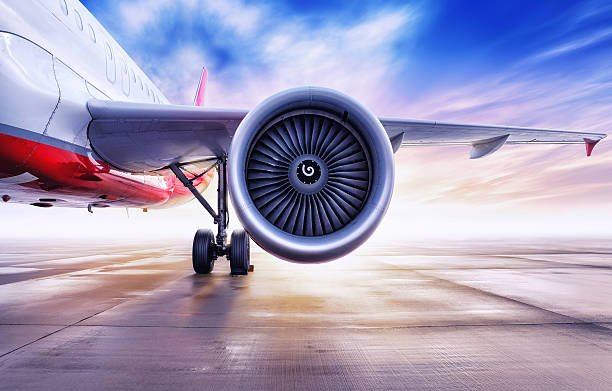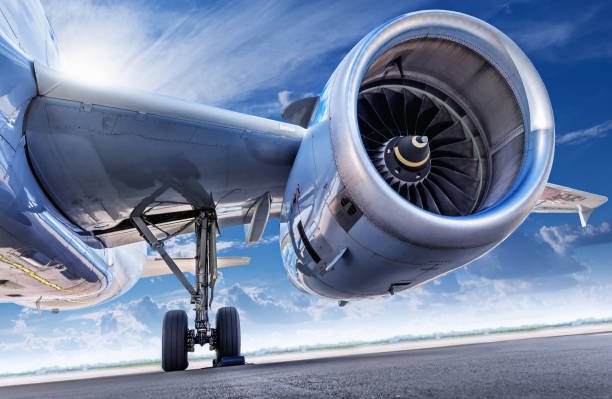How Does Jet Engine Works? Complete 2023 Guide
How Does Jet Engine Work? Jet engines are the most powerful type of engine in the world. They are used to power airplanes, helicopters, and even spacecraft. But how do they work?
In a nutshell, a jet engine works by converting the chemical energy of fuel into kinetic energy. This is done by burning the fuel in a combustion chamber, which creates hot exhaust gases. These gases are then forced through a turbine, which spins a shaft. The shaft is connected to a compressor, which compresses the air that is entering the engine. This compressed air is then mixed with the fuel and ignited, creating the hot exhaust gases that power the turbine.
In this article, we will dig deeper on how a jet engine works, the types of jet engine, it’s future and some frequently asked questions around the net.
Get your popcorn????and juice or beer ready and without further delay, let’s get started.
The Basics of a Jet Engine

A jet engine is made up of four main components: the compressor, the combustion chamber, the turbine, and the nozzle.
- The compressor is a series of rotating blades that compress the air that is entering the engine. This increases the pressure of the air, which makes it easier to ignite and burn.
- The combustion chamber is where the fuel is burned. The air that has been compressed by the compressor is mixed with the fuel and ignited. This creates hot exhaust gases.
- The turbine is a series of rotating blades that are turned by the exhaust gases. The turbine is connected to a shaft, which is also connected to the compressor. This means that the turbine spins the compressor, which helps to compress the air that is entering the engine.
- The nozzle is the part of the engine that the exhaust gases exit from. The nozzle is designed to control the speed of the exhaust gases. This is important because the speed of the exhaust gases determines the thrust of the engine.
How Does Jet Engine Works
A jet engine works by converting the chemical energy of fuel into kinetic energy. This is done by burning the fuel in a combustion chamber, which creates hot exhaust gases. These gases are then forced through a turbine, which spins a shaft. The shaft is connected to a compressor, which compresses the air that is entering the engine. This compressed air is then mixed with the fuel and ignited, creating the hot exhaust gases that power the turbine.
The process of how a jet engine works can be broken down into four main steps:
- Air intake: The first step is to intake air into the engine. This is done by the compressor, which is a series of rotating blades that compress the air. The compressed air is then mixed with fuel in the combustion chamber.
- Combustion: The second step is to combust the fuel and air mixture. This is done by igniting the mixture with a spark plug. The combustion process creates hot exhaust gases.
- Turbine: The third step is to use the hot exhaust gases to power the turbine. The turbine is a series of rotating blades that are turned by the exhaust gases. The turbine is connected to a shaft, which also rotates the compressor.
- Nozzle: The fourth step is to expel the exhaust gases out of the nozzle. The nozzle is designed to control the speed of the exhaust gases. The speed of the exhaust gases determines the thrust of the engine.
The thrust of a jet engine is the force that propels the airplane forward. The thrust is created by the exhaust gases exiting the nozzle at high speed. The faster the exhaust gases, the greater the thrust. The thrust of a jet engine is also affected by the mass of the exhaust gases. The more mass the exhaust gases have, the greater the thrust.

Jet engines are a very efficient way to convert the chemical energy of fuel into kinetic energy. They are also very powerful, and they can propel airplanes to very high speeds. Jet engines are an essential part of modern aviation, and they are used in airplanes, helicopters, and even spacecraft.
Types of Jet Engines
There are many different types of jet engines. Some of the most common types include:
- Turbojet engines: These are the simplest type of jet engine. They are made up of a compressor, a combustion chamber, a turbine, and a nozzle. Turbojet engines are very efficient at high speeds, but they are not very efficient at low speeds.
- Turbofan engines: These are the most common type of jet engine. They are similar to turbojet engines, but they have a fan in front of the compressor. The fan helps to increase the mass of the air that enters the engine, which increases the thrust. Turbofan engines are more efficient than turbojet engines at low speeds.
- Turboprop engines: These engines are used to power propeller airplanes. They are similar to turbojet engines, but they have a propeller instead of a nozzle. The propeller helps to convert the thrust of the engine into forward motion. Turboprop engines are more efficient than turbojet engines at low speeds.
- Turboshaft engines: These engines are used to power helicopters. They are similar to turboprop engines, but they have a shaft instead of a propeller. The shaft is connected to a rotor, which creates the lift that allows the helicopter to fly. Turboshaft engines are more efficient than turbojet engines at low speeds.
Other types of jet engines:
- Ramjet engines: Ramjet engines do not have a compressor. Instead, they rely on the forward motion of the aircraft to compress the air that enters the engine. Ramjet engines are very efficient at high speeds, but they cannot operate at low speeds.
- Scramjet engines: Scramjet engines are a type of ramjet engine that can operate at supersonic speeds. Scramjet engines are still in development, but they have the potential to be very efficient at high speeds.
The type of jet engine that is used depends on the application. Turbojet engines are typically used for fighter jets and high-speed aircraft. Turbofan engines are typically used for commercial airplanes and other large aircraft. Turboprop engines are typically used for propeller airplanes. Turboshaft engines are typically used for helicopters.

The future of jet engine technology is bright. New technologies are being developed that will make jet engines more efficient, quieter, and cleaner. These new technologies will make jet engines more sustainable and will help to reduce the environmental impact of air travel.
The Future of Jet Engines
The future of jet engines is bright. New technologies are being developed that will make jet engines more efficient, quieter, and cleaner.
One of the most promising new technologies is the use of variable geometry turbines. These turbines can change their shape to optimize the engine’s performance at different speeds. This will make jet engines more efficient at both low and high speeds.
Another promising new technology is the use of synthetic fuels. Synthetic fuels are made from renewable sources, such as biomass or solar energy. They burn cleaner than traditional jet fuels, which will reduce the environmental impact of jet engines.
10 Frequently Asked Questions
1. What is the most common type of jet engine?
The most common type of jet engine is the turbofan engine. Turbofan engines are more efficient than turbojet engines at low speeds, which makes them ideal for commercial airplanes.
2. How do jet engines work in reverse?
Jet engines can work in reverse by reversing the flow of the exhaust gases. This is called thrust reverse, and it is used to slow down airplanes when they are landing.
3. How much thrust does a jet engine produce?
The amount of thrust that a jet engine produces depends on the size of the engine and the type of fuel that is used. A typical jet engine can produce up to 100,000 pounds of thrust.
4. How hot does a jet engine get?
The temperature inside a jet engine can reach up to 1,500 degrees Fahrenheit. The hot air is what helps to ignite the fuel and create the thrust.
5. How loud are jet engines?
Jet engines can be very loud, especially when they are taking off or landing. The noise is caused by the exhaust gases and the fan blades.
6. How much fuel does a jet engine use?
The amount of fuel that a jet engine uses depends on the size of the engine, the type of airplane, and the flight conditions. A typical jet engine can use up to 1,000 gallons of fuel per hour.
7. How long do jet engines last?
Jet engines can last for many years, with some engines lasting for over 20,000 hours. The lifespan of a jet engine depends on the maintenance and the operating conditions.
8. What are the environmental impacts of jet engines?
Jet engines emit greenhouse gases, such as carbon dioxide and water vapor. They also emit pollutants, such as nitrogen oxides and sulfur oxides. These emissions can contribute to climate change and air pollution.
9. What are the future trends in jet engine technology?
The future trends in jet engine technology include the development of more efficient engines, quieter engines, and cleaner engines. New technologies, such as variable geometry turbines and synthetic fuels, are being developed to achieve these goals.
10. What are some of the challenges facing the jet engine industry?
The jet engine industry is facing a number of challenges, including the rising cost of fuel, the increasing demand for air travel, and the need to reduce emissions. The industry is working to address these challenges by developing more efficient engines and by using alternative fuels.

Final Thought
Jet engines are an amazing feat of engineering. They are able to convert the chemical energy of fuel into kinetic energy, which propels airplanes, helicopters, and spacecraft.
Jet engines are an essential part of modern aviation. They allow us to travel long distances quickly and efficiently. However, jet engines also have a significant environmental impact. They emit greenhouse gases and pollutants that contribute to climate change and air pollution.
The good news is that there are new technologies being developed that will make jet engines more efficient, quieter, and cleaner. These technologies, such as variable geometry turbines and synthetic fuels, have the potential to make a significant difference in the environmental impact of jet engines.
As the demand for air travel continues to grow, it is important that we develop more sustainable jet engine technologies. These technologies will help to reduce the environmental impact of air travel and make it more environmentally friendly.
In addition to the environmental benefits, more efficient and cleaner jet engines will also have economic benefits. They will reduce the cost of fuel and make air travel more affordable. They will also improve air quality, which will have a positive impact on human health.
The future of jet engines is bright. New technologies are being developed that will make them more efficient, quieter, and cleaner. These technologies have the potential to make a significant difference in the environmental impact of jet engines and make air travel more sustainable.
I hope this helps! Let me know your thoughts on jet engines in the comment section. Also, share this article????.
